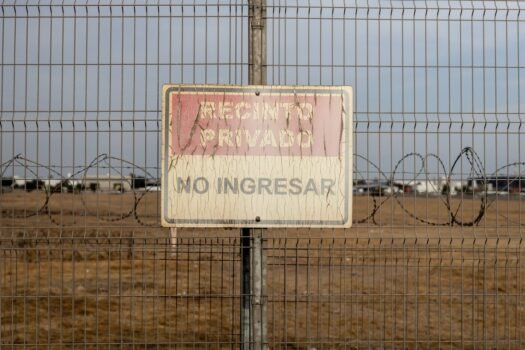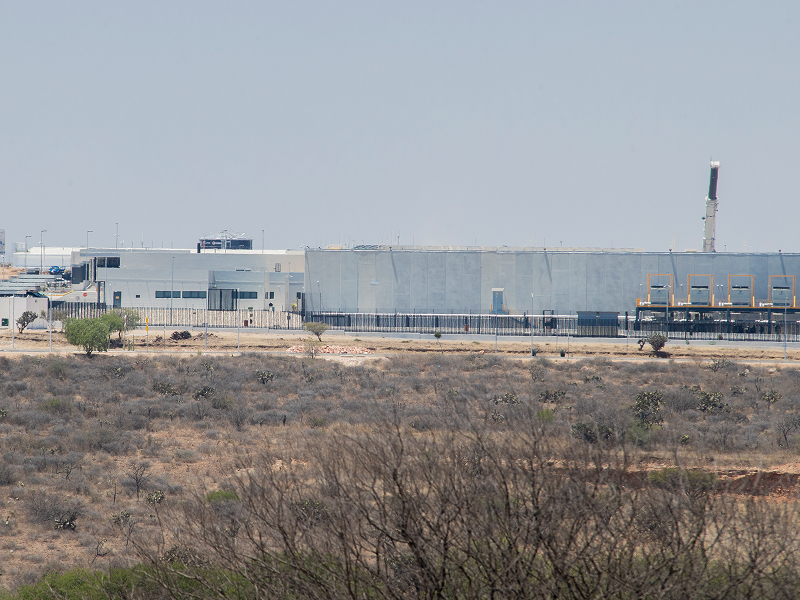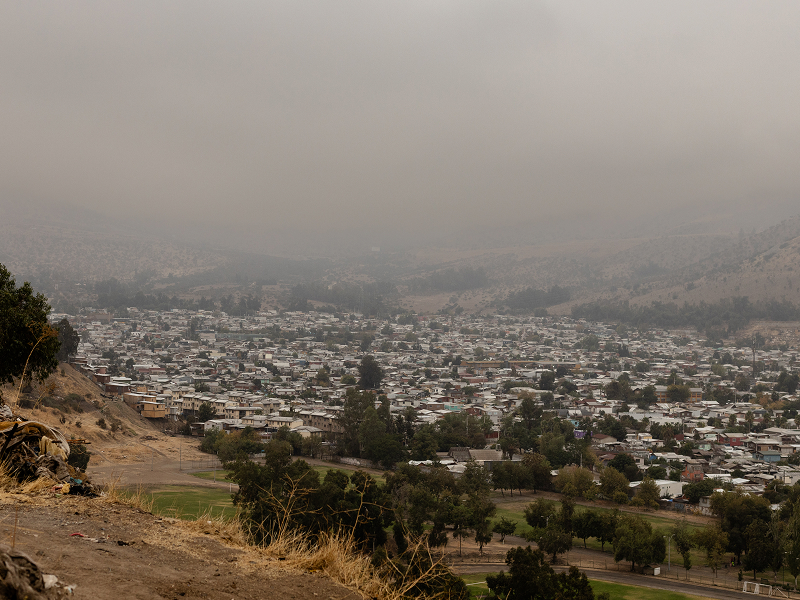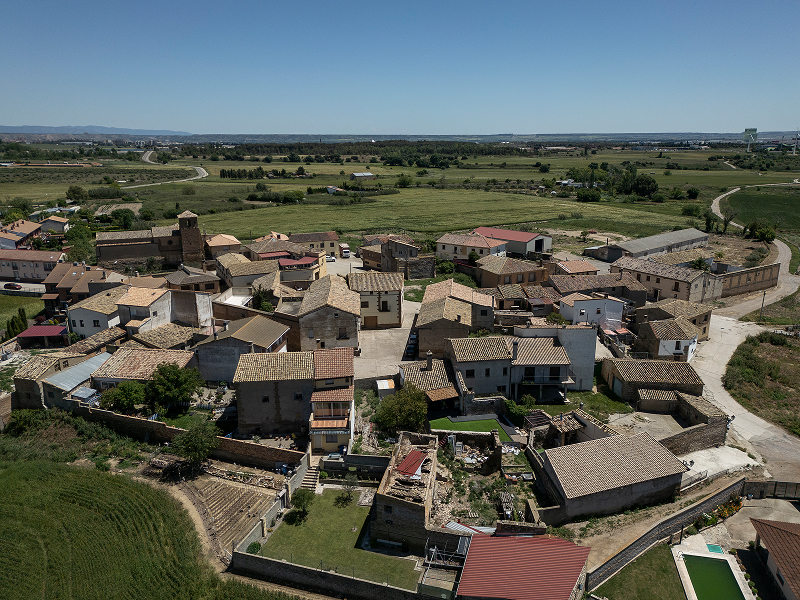Mrs. Hortensia looks away for a moment from the potatoes she is busily peeling, one after another. “We’d be better off if they gave us a health clinic,” she says, nodding slightly to her right.
An old shipping container converted into a mobile classroom sits closed next to the taco stand Hortensia runs with her sisters. It is a holiday in La Esperanza, a rural community in the Mexican state of Querétaro, and the person who comes during the week to give “computer classes” is not here today. On the front of the classroom is a Microsoft logo. Hortensia explains that she hardly ever sees anyone go in, and that, in any case, the classes they give there would be of little use to her.
Just over a mile uphill from Hortensia’s stand, the U.S. tech company is building a massive data center complex. One building full of servers running day and night has been operating since 2024. The other is already in the final phase of construction.
The computer towers inside are just one piece of a vast global network — a web of buildings larger than football fields that Microsoft and other internet giants, such as Amazon and Google, are spreading across the planet. At a breakneck pace. And with a common goal: to satisfy the enormous computing demands that their artificial intelligence (AI) models — the largest and also the least eco-friendly — require to function.
In La Esperanza, as in more and more places around the world, the cloud is taking physical form. But Hortensia, like her neighbors, doesn’t know what happens inside those buildings. What she does speak about with confidence is how the surroundings of La Esperanza have changed in recent years. A string of industrial parks has sprung up to the north and east of the capital of this Mexican state — without, she points out, bringing any benefits to the surrounding communities.
Perhaps the opposite is true. Recently, water outages in this and other nearby communities have become common — a problem that didn’t exist a few years ago. “These companies should give something back to the community. But they don’t,” says Hortensia, resignedly, glancing again at the classroom with the Microsoft logo. “The benefits are only for them.”
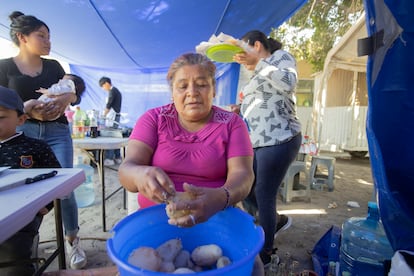
The La Esperanza data center is one of a dozen projects studied by EL PAÍS and the Pulitzer Center for this report. These are projects driven by Microsoft, Amazon, and Google — the three corporations (alongside Meta) now locked in a fierce battle over the infrastructure that underpins the AI race. And they are located not only in Querétaro, Mexico, but also in Santiago de Chile, Chile, and Aragón, Spain — three regions separated by thousands of miles but sharing a common thread: in record time, they have become priority destinations for this multibillion-dollar industry.
As the debate over AI’s environmental costs grows louder, this investigation maps the local impacts of a key link in its supply chain.
Amazon, Microsoft, and Google — amid their frenzied race — are now extracting basic resources such as water in areas facing severe droughts. They are also seizing large tracts of land to build their centers and the power grids that feed them. All under a veil of secrecy that, at times, includes the use of shell companies and, in almost all cases, the complicity and collusion of local authorities. The companies mentioned declined to be interviewed in depth for this report.
Mexico
The plundering of water in the data center corridor
At the La Esperanza spring, sediment marks the line where the water used to reach. Until recently, residents would come here to fill buckets. But the amount stored today is so low that soil and roots are visible below the cement structure that protects this natural source.
Manuel Rodríguez Lorenzo uses the spring as an example to illustrate how water has become an increasingly scarce resource here in recent years. “Sometimes we go without water for up to 15 days,” says the community delegate of La Esperanza and seven other rural communities in Colón, a municipality in Querétaro. Water rationing, or el tandeo, has already become routine in most of them, he explains — that is, supplying water in shifts between streets or groups of houses in the town, which means others go days without it.
When asked about the water consumption of the Microsoft data center next door, Rodríguez Lorenzo assumes a poker face. This community representative, elected to serve as a liaison between the municipality and the rural populations, is surprised to learn that these complexes need water to operate. “We didn’t have that information,” he admits.
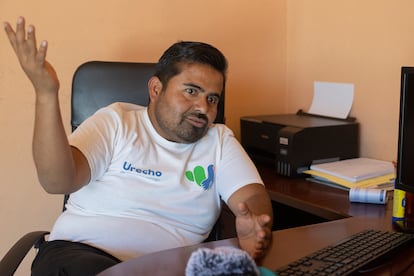
Like all the data centers already built and analyzed in this report, the two Microsoft buildings near La Esperanza are surrounded by extreme security. Surveillance cameras, private security personnel, and multiple fences perimeter the complex — one of the three that the tech company has operated since 2024 in Querétaro.
This Mexican state, one of the safest in the country but also one of the most affected by drought, has positioned itself in just three years as a key location for the hyperscale industry. Between May of last year and January of this year, Microsoft, Google, and Amazon Web Services (AWS) — the cloud business branch of Amazon — began operating here, confirms Marco del Prete, Secretary of Sustainable Development of the Querétaro government.
This high-ranking official, who has made attracting large foreign investments one of his political banners, quantifies the completed data centers as “seven units.” The figures provided by Del Prete stop here. Unlike other regions around the globe, in Querétaro it is very difficult to pinpoint the data centers of the major tech companies on the map.
Local authorities guard this information closely, as well as details related to their energy and water consumption. The launch of ChatGPT in November 2022 completely transformed this industry. Until then, these server farms were designed with data traffic from products like web search engines, email, or e-commerce in mind. The boom of generative AI has ushered in a new era. Today, the equipment housed in these buildings operates with much more powerful microprocessors.
The heat emitted by these chips, which require unprecedented amounts of energy, is a problem for companies, especially in warm, dry climates like Mexico’s. Although cooling solutions are evolving within the industry, hyperscalers still rely heavily on water as a key component of their cooling systems.
In Querétaro, the state government says it does not know how the major data center operators cool their equipment during the hottest months. “It is not within my authority to ask a data center how it cools its servers, just as it is not to ask an office building about its cooling system,” argues Del Prete.
However, information obtained in this investigation shows how several of these complexes are currently extracting water from underground aquifers that are in a critical state. These natural reserves also provide water to the populations living in nearby rural communities.
Just 10 minutes south of La Esperanza is the Vesta industrial park. Highway 100 crosses what Del Prete and his team have dubbed the new Querétaro Technology Corridor — a succession of industrial facilities on both sides of the road where completed and under-construction data centers are spreading like mushrooms.
At Vesta, the Brazilian company Ascenty, which leases its servers to third parties, opened a single-building data center in 2022. A new building was constructed on the adjacent plot last year. The evidence gathered indicates that Microsoft currently uses both facilities as part of its new “data center region” in Mexico.
In October 2023, a subsidiary of the tech company obtained a permit to extract 25 million liters of water annually right next to this complex, according to the public water rights registry of CONAGUA, the public agency attached to the federal government that issues these permits.
The water extracted from this and the other wells identified in this investigation comes from the San Juan del Río Valley aquifer, a water source that is overexploited and has a deficit of 56.9 million liters, according to CONAGUA data. A 2024 report from the agency indicates that the aquifer lacks “availability of groundwater” for new permits.
On the same day Microsoft obtained its permit, authorities granted another concession for a well located just 500 meters from this complex. In this case, the amount was 23 times higher (575 million liters annually) and issued to a real estate company that manages this and other industrial parks in the country.
EL PAÍS asked Microsoft whether, in addition to the well under its name, it holds other extraction permits in this aquifer, as well as the volume and duration of those permits. The company did not respond to this and other inquiries for this report.
“To supply water to their data centers, these companies rely on wells whose permits are under other names and for other uses. That’s why it’s complicated to track them down,” explains Lorena García Estrada, professor and environmental geographer at the University of Querétaro.
This researcher has been studying the water impacts of this industry in the region for months and warns that the picture provided by public records is far from complete. Many companies, she points out, acquire their water rights through the parks where they are located. “Also, if the concessions have just been acquired, the registry information may not yet be updated. And a well that the registry shows as belonging to a person or company might now belong to a data center,” she adds.
Viborillas is just under a mile from the Vesta park. Like La Esperanza, it is one of the communities that were there before the industrial complexes that now flood Colón appeared.
Dulce Jiménez explains how access to water has worsened greatly in recent years, especially since the pandemic. “My family is very careful with water and we reuse it, so it doesn’t affect us as much,” says this young woman from behind the counter of her store, as she waits for a group of children to leave the small church across the street.
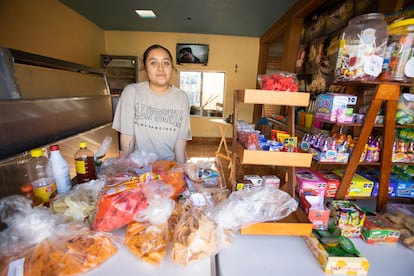
One of the women waiting for the children complains that the water they receive is not enough “to fill the tinaco [water tank]” in her home. However, when it rains, the lower streets of the town quickly flood, and “no one fixes the drainage,” she protests.
Between 2021 and 2022, Microsoft, in collaboration with the United Nations agency U.N.-Habitat, conducted an analysis of the social and economic needs of these populations. This work resulted in an “action plan” in which both organizations highlighted the severe water crisis in the area and proposed several recommendations. According to testimonies collected in Viborrillas and La Esperanza by EL PAÍS, none of the proposals have been implemented.
As Highway 100 heads north, the greenery diminishes on both sides and on the horizon. Shortly after the turnoff to La Esperanza, a detour provides access to the Microsoft data center near this community, built on a hill that rises several meters above it.
Here, CONAGUA records show three wells with a total allocation of 600 million liters per year. The holder of these concessions is a company linked to the University of Arkansas in the U.S., which has its own campus on the land adjacent to the tech complex. This newspaper was not able to confirm whether any of this water is directed to Microsoft’s data center.
Sección de citas destacadas
Cita destacada

“It is serious that such large companies take advantage of the opacity in Mexico to do as they please.”
Lorena García Estrada, researcher at the University of Querétaro
Sitting in a café in Santiago de Querétaro, the state capital, García Estrada explains in detail the transformation experienced over the past two decades by the municipalities near this city. The construction of the new international airport, opened in 2004, rapidly industrialized the area. But it also led to “processes of land grabbing and dispossession” for nearby communities, according to this researcher’s doctoral thesis, whose title includes a telling subhead: “From million-dollar profits to forgotten towns.”
García Estrada warns that the dynamics generated back then may be repeating today with the data center boom. She points to the enormous opacity surrounding these infrastructures in Querétaro as a shared responsibility between authorities and companies.
This lack of information affects both the communities living alongside these infrastructures and the local voices, like hers, trying to shed light on this rapidly expanding industry. “It is serious that such large companies take advantage of this opacity in Mexico to do as they please,” she concludes.
Chile
Resistance on the outskirts of Santiago
“Here, the people will not allow those towers to be installed. They absolutely won’t allow it.”
Patricio “Pato” Hernández speaks confidently about the future of Punta Mocha hill that surrounds La Pincoya. From the top of this mountain, on one side you see the low houses of this working-class neighborhood in northern Santiago, Chile. On the other side are the lands where Amazon Web Services will build one of its three new data centers in the Chilean capital.
Hernández traces in the air with his finger the path that the 24 high-voltage towers will follow. A 2.2-mile power line will connect the substation nestled among the houses of La Pincoya with one corner of the nearly 10-hectare plot owned by AWS.
Two and a half years ago, he and other neighbors found out about both projects while checking the website of the Environmental Assessment Service (SEA), the public agency responsible for granting environmental permits. There, they saw that the power line would cross this sort of public park — the only green space in this densely populated neighborhood located in the Santiago municipality of Huechuraba.
The towers project was signed by an unknown company that, just a month later, informed the authorities that it was withdrawing. Around the same time, they encountered a new initiative whose owner, this time, was easy to identify. AWS’s Chilean subsidiary began the procedures to build the first of three data centers it plans to establish in the Andean country. In May of this year, the Chilean government officially announced the investment.
Hernández explains that after reviewing the reports submitted to the SEA, they quickly linked both projects. It was then that several neighborhood organizations began sustained activism. “For several weeks, we held mural painting sessions, street campaigns, talks, and invited other neighbors to inform them,” he recounts.
Sección de citas destacadas
Cita destacada

“We told Amazon that the community has a connection to the hill and that we will not allow them to install [the towers] here.”
Patricio Hernández, resident and activist from La Pincoya
In April 2023, AWS held a public hearing open to the residents. Company representatives defended the benefits of the data center for the community. But their arguments didn’t convince the attendees, who made clear their anger at the company for trying to administratively separate the two projects. “No to Amazon! No to Amazon!” they shouted.
“We also told them that if the project was as wonderful as they were saying, then they could go build it in an upscale neighborhood,” Hernández recalls.
The term hyperscale refers to how internet giants design next-generation data centers. Unlike smaller colocators, these infrastructures must be able to progressively scale workloads at the pace demanded by the AI business — adding more servers or more powerful chips, and, if necessary, building new facilities from scratch.
The AWS complex in Huechuraba is an example of this design. The documentation provided by the company explains that it will have “three phases.” In the first, the data center will be powered through medium voltage and connected to the existing electrical infrastructure. On the other hand, the second and third phases depend “on the existence of a concessionary electrical company that can provide the required supply,” the tech company argues in its response to the latest objections raised by residents.
Officially, the high-voltage power line project has been “withdrawn” before the authorities. However, evidence gathered by Patricio Hernández and verified by this investigation shows the connection between AWS’s Chilean subsidiary and Santa Teresa Inversiones Corp. — a business group that appears to be facilitating the tech company’s plans in the country, including the construction of the towers needed for the second and third phases of the Huechuraba center.
These documents are just a sample of the corporate network the tech company appears to have created to carry forward its mega-project in Chile with as much discretion as possible. This multimillion-dollar investment includes another similar complex in the municipality of Padre Hurtado, south of Santiago, and a third in a location yet to be confirmed.
All of this falls under the umbrella of Santa Teresa Inversiones, currently the owner of Inmobiliaria STPH and other companies with significant recent activity in the real estate and energy sectors. “Even though the project has already been withdrawn, this company owns the land where the towers’ route will pass,” Hernández affirms.
When asked by EL PAÍS about its ties to this business group, AWS sources declined to comment. Regarding the opposition from La Pincoya residents to the data center, a company spokesperson responded that they work to ensure the communities where they operate “continue to be great places to live, work, and thrive.” “We are committed to being good neighbors and dedicate a great deal of time to listening to and understanding the needs and priorities of the communities,” they added.
Almost two hours by public transportation from La Pincoya is Cerrillos. In this municipality on Santiago’s southern outskirts, one of those unlikely events was confirmed last year: a Chilean environmental court ruled a Google data center — designed to be the largest in Latin America — as irregular after years of sustained opposition by a group of residents.
From beyond the fences protecting the tech giant’s vast lot, Tania Rodríguez watches as a truck carries out surveys inside the site. Rodríguez wonders if, as on other occasions, they might be doing so without the proper permits. She also points to the trash along the edges of the lot, adjacent to a shopping center and one of the heavily used roads crossing Santiago’s outskirts.

“Google is not a good neighbor, not at all. It never has been,” exclaims this resident and activist, who in 2024 was named by Time magazine as one of the 100 most influential people in the world of AI.
The judge who halted Google’s project last year ruled that neither the company nor the authorities took into account, in their initial assessment, the likely impact of the data center on Santiago’s central aquifer, amid climate change and a severe water crisis. By then, the company had already withdrawn its project following years of complaints and protests led by the Mosacat collective, of which Rodríguez is a spokesperson.
Members of this group say that in recent months representatives from the tech company have met again with local stakeholders to gauge the municipality’s mood and explore the viability of a new project at the same location, which would significantly reduce water usage. When asked about this, Google sources said the company has not initiated any official process yet but noted that “any new project would be for a data center using air-cooling technology.”
However, this proposal still fails to convince Mosacat members. They understand that what would be the tech giant’s second complex in Santiago — the other has been operating since 2015 in the Quilicura municipality, north of the city — would only bring costs and no benefits. “This is not about opposing technological advances or development. On the contrary, it’s about respecting nature and ensuring both go hand in hand. And also, it’s not fair that only our communities are sacrifice zones,” Rodríguez asserts.
Today, this activist recalls how the start of the mobilization against Google coincided with the massive protests that swept Chile between late 2019 and early 2020, and how their demands were fueled “by the spirit of resistance that was in the air at the time.”
She also remembers the irony that Cerrillos was originally slated to host that year’s United Nations Climate Change Conference (COP25), an event that ultimately took place in Madrid precisely because of the protests in the Andean country. “We’re in the outskirts, where we’re always polluted and where land is cheaper — that’s why they come here,” Fernández says, while, out of the corner of her eye, she keeps watching the truck surveying the lot.
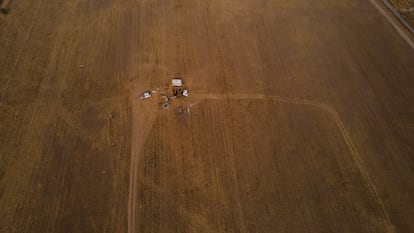
Google’s experience in Cerrillos is a virtually unique case worldwide, note various Chilean and international researchers. The halt to the Silicon Valley giant’s plans, those sources point out, has transformed how many data center companies establish themselves in communities such as this one.
The companies are now more cautious and adapt their strategies if they detect any opposition on the ground — a trend that could explain AWS’s moves in La Pincoya.
Patricio Hernández recounts how the first settlers arrived in this neighborhood in the 1950s. Entire families, like in other areas on the outskirts of Santiago, migrated from rural areas to the city, turning Chile’s capital into the metropolis of over seven million inhabitants it is today.
These settlers used to climb Punta Mocha hill in their free time to stay connected with nature in an area that experienced rapid industrialization. This also fostered a strong class consciousness within the neighborhood, which became one of the most combative against Pinochet’s dictatorship. In the “historic sector” of Huechuraba, Hernández notes, the children and grandchildren of those first settlers still live.
For many of them, the hill holds a deep emotional connection to their past — and also to their present. “People go there to run and stroll. They even go there to pololear [date],” says this resident, convinced that the neighborhood will ultimately stop the data center Amazon plans to build here.
Spain
Opacity and expropriations in “the New Virginia”
Last February, the residents of Cuarte, a hamlet in the municipality of Huesca, Spain, were surprised when they opened their mailboxes. A letter signed by a law firm from Madrid informed them of the expropriation of certain lands.
The list included agricultural farms owned by their families for generations, as well as several plots where their homes now stand. The letters specified that these lands were affected by the expansion of AWS’s data center region in Aragón.
The letters sparked a mix of uncertainty and indignation among the residents of Cuarte, explains David Lanuza, a local. In this small village surrounded by fields and just a 10-minute drive from Huesca, no one had known the project’s details until then. Nor had they heard about the underground power line the tech company planned to install to supply a new center in the Walqa industrial park, located less than a mile away, around which the expropriations were justified.
“The most surprising thing was that the cable ran through the center of the town, even though there are many alternatives nearby,” Lanuza emphasizes. “There was no need. Besides, we were already here, and the cable doesn’t even supply the town.”
Like Querétaro and Santiago de Chile, Aragón has quickly become a desirable destination for AI infrastructure. AWS opened three data centers in 2022 in the towns of El Burgo de Ebro, Villanueva de Gállego, and the PHLUS industrial estate, also in Huesca.
In addition to expanding several of these complexes, the company will also build two completely new ones: the aforementioned Walqa complex and another in La Cartuja, Zaragoza. This macro-project, once completed, will have a combined energy consumption of over 10,800 GWh, well above the current demand generated throughout the region of Aragón.
At a meeting with other town residents, Carlos Oliván points to a map with the detailed layout of the electrical conduit. The sheet is part of the extensive technical documentation that the Cuarte residents reviewed in January after receiving the letters. The noise they generated prompted several representatives from the technology company to come to the town to meet with them. At the meeting, the company pledged to reroute the cable. It also floated the possibility of carrying out some form of compensation project based on their needs.
“In any case, they present this as a favor, as a show of goodwill. But they’ve never talked about a restitution plan, which I think should be a priority,” Oliván says.
Several residents of Cuarte are grateful today that the company has “reconsidered” the pipeline issue. But others remain cautious and doubt that AWS will ultimately fulfill the verbal promise it made to them. When questioned by EL PAÍS, a company spokesperson stated that “AWS has modified the route of the underground power line” and that these changes will be reflected in writing in the final approval of the project.
What everyone in Cuarte agrees on is their concern about another detail of the project. The company will install several wells on its plots to extract groundwater for cooling the equipment. Three will be in Walqa and two more in El Burgo, a town near Zaragoza and irrigated by the Ebro River.
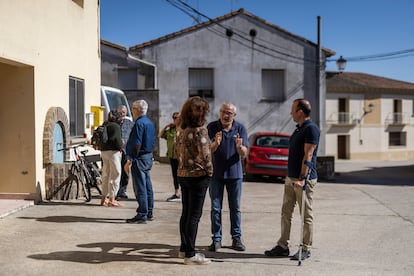
Carlos López, a member of Ecologists in Action in Aragón, argues that these wells, once they begin extracting water from the groundwater table, will lack proper oversight by the authorities. They will thus be at the mercy of the company’s needs and the stubborn reality of climate change. “It won’t be possible to prove how much water they are going to extract,” the activist argues, going on to point out that Amazon acknowledged this year that it has been using 48% more water in its already operational centers as of 2022. The reason, the company justified, is an incorrect initial estimate of very hot days, when the fans that cool the equipment must be sprayed with water.
Sources from the Ebro River Basin Authority (CHE) confirm that Amazon has already requested authorization to drill at its facilities in Huesca, but clarify that the process is still in its initial stages. They also point out that if they are ultimately authorized, CHE will ensure that these wells “comply with the conditions established in the authorizations or concessions, especially regarding the maximum volume granted.”
Along the same lines, an AWS spokesperson assures that the extraction wells “are subject to strict regulatory oversight” and were designed “as backup water sources” for the centers’ operations.
Sección de citas destacadas
Cita destacada

“It won’t be possible to prove how much water Amazon is going to extract”
Carlos López, member of Ecologists in Action in Aragón
Cita destacada

“There is no guarantee that any of their promises will be fulfilled, nor even the ability to monitor those promises”
Álvaro Sanz, United Left deputy in Aragón
As in other regions where this industry has gained ground, the Aragón regional government has made the establishment of technology corporations one of its hallmarks. In recent months, Jorge Azcón, regional premier of Aragón, has repeatedly referred to the area as “the new Virginia,” referring to the U.S. state that hosts the largest concentration of this infrastructure in the world.
In addition to AWS, Microsoft has already received approval for the construction of three new hyperscale centers in the Zaragoza area. The same applies to the infrastructure that the Blackstone and Azora funds will install in Calatorao and Villamayor de Gállego, respectively. The latter has been met with protests by the city council and residents.
The regional government of Aragón confirms that all of them are being processed as projects of “general interest” for the community (known as a DIGA), an administrative framework for initiatives with a significant impact on the economy and employment. Among other things, it speeds up bureaucratic procedures and facilitates expropriations.
One of the biggest questions surrounding data centers that neither companies nor authorities have answered concerns job creation. An internal document from the AWS subsidiary in Spain, to which this investigation has had access, provides clues to quantify how many new jobs these types of projects generate once they are operational (as opposed to during the construction phase).

This report indicates that, as of October 2021, the total number of direct employees at each of the three centers in Aragón did not exceed 20. During that time, the multinational was testing the systems within the complex before beginning operations. A company spokesperson states that these figures “do not represent the number of employees in our data centers today,” but did not clarify how many full-time workers are employed there.
“There is a worrying trend toward embracing projects that respond to a specific development model and failing to analyze their environmental and energy needs,” says Álvaro Sanz, a member of the Izquierda Unida (United Left) party in Aragón.
His party has presented several parliamentary initiatives demanding greater transparency and oversight of this industry, especially regarding its real economic impact and companies’ environmental commitments. “There is no guarantee that any of their promises will be fulfilled, nor even the ability to monitor those promises,” he warns.
Despite its proximity to the Pyrenees, Huesca and its surrounding areas have seen a rapid decline in their water reserves in recent years. In Cuarte, Carlos Oliván recites the long list of natural springs that this town had until recently. All that remains, he explains, is the small spring that provides drinking water to the town and the Fuente de Las Calenturas, “which used to spout a jet like this,” Oliván gestures, opening his arms, “which could water six or eight orchards, but now it spouts little more than a jug.”
Residents of this town fear that Amazon’s planned extraction of underground reserves will directly affect them, especially those with orchards and farms. “If Amazon screws up all the springs, Cuarte will be left without water,” one of them exclaims.

David Lanuza adds another source of uncertainty to the equation: “We don’t know the full scope of the project when it’s all finished.” A few weeks ago, the press reported that AWS will open a 12-meter-wide road next to Cuarte while the construction work continues. “I understand they’re going to restore it, but there’s very little information about all the processes,” Lanuza comments.
“When the project is finished, what will its final impact be? […] We don’t know if there will be another DIGA or not. And that’s part of the uncertainty we have: not knowing how our environment will be affected in 20 years,” he concludes.
Credits
Formatting: Brenda Valverde Rubio
Design: Ana Fernández
Development: Alejandro Gallardo
Infographics: Yolanda Clemente
Contributor in Chile (researching and reporting): Muriel Alarcón
This investigation was conducted with the support of the Pulitzer Center’s AI Accountability Network.
Sign up for our weekly newsletter to get more English-language news coverage from EL PAÍS USA Edition


